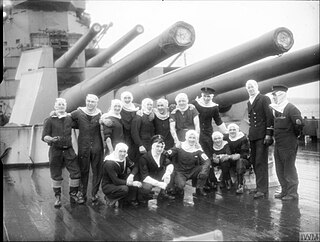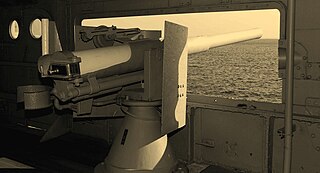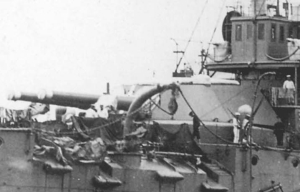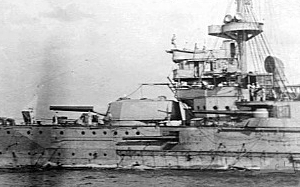
The BL 15-inch Mark I succeeded the BL 13.5-inch Mk V naval gun. It was the first British 15-inch (380 mm) gun design and the most widely used and longest lasting of any British designs, and arguably the most successful heavy gun ever developed by the Royal Navy. It was deployed on capital ships from 1915 until 1959 and was a key Royal Navy gun in both World Wars.

The BL 13.5 inch Mk V gun was a British heavy naval gun, introduced in 1912 as the main armament for the new super-dreadnought battleships of the Orion class. The calibre was 13.5 inches (343 mm) and the barrels were 45 calibres long i.e. 607.5 inches. The guns were greatly superior to the unrelated earlier 13.5-inch (30-calibre) Mk I to Mk IV guns used on the Admiral, Trafalgar and Royal Sovereign classes completed between 1888 and 1896.

The BL 16-inch Mark I was a British naval gun introduced in the 1920s and used on the two Nelson-class battleships. A breech-loading gun, the barrel was 45 calibres long meaning 45 times the 16-inch (406 mm) bore – 60 ft (18 m) long.

The BL 14-inch Mk VII naval gun was a breech loading (BL) gun designed for the battleships of the Royal Navy in the late 1930s. This gun armed the King George V-class battleships during the Second World War.

The QF 6-inch 40 calibre naval gun (Quick-Firing) was used by many United Kingdom-built warships around the end of the 19th century and the start of the 20th century. In British service it was known as the QF 6-inch Mk I, II, III guns. As the 15 cm/40 (6") 41st Year Type naval gun it was used for pre-dreadnought battleships, armoured cruisers and protected cruisers of the early Imperial Japanese Navy built in UK and European shipyards. It was also the heaviest gun ever carried by a pre-Cold War destroyer.

The QF 12-pounder 12-cwt gun (Quick-Firing) was a common, versatile 3-inch (76.2 mm) calibre naval gun introduced in 1894 and used until the middle of the 20th century. It was produced by Armstrong Whitworth, Elswick and used on Royal Navy warships, exported to allied countries, and used for land service. In British service "12-pounder" was the rounded value of the projectile weight, and "12 cwt (hundredweight)" was the weight of the barrel and breech, to differentiate it from other "12-pounder" guns.

The Armstrong Whitworth 12-inch naval gun of 40 calibres length was designed by and manufactured mainly by Armstrong's ordnance branch, Elswick Ordnance Company. It was intended for the Royal Navy's Royal Sovereign-class battleships, but budgetary constraints delayed their introduction. The first units were instead supplied to Japan. As the Type 41 12-inch (305 mm) 40-calibre naval gun it was the standard main battery on several early United Kingdom-built pre-dreadnought battleships of the Imperial Japanese Navy.

The Vickers 10 inch naval gun was used on battleships and armoured cruisers built during the first decade of the 20th century. They were used as the Type 41 10-inch /45-caliber aboard the British-built semi-dreadnought Katori-class battleships and the natively-built Satsuma-class battleships of the Imperial Japanese Navy.

The BL 4-inch gun Mk VII was a British high-velocity naval gun introduced in 1908 as an anti-torpedo boat gun in large ships, and in the main armament of smaller ships. Of the 600 produced, 482 were still available in 1939 for use as coastal artillery and as a defensive weapon on Defensively Equipped Merchant Ships (DEMS) during the Second World War.

The BL 6-inch Mark XI naval gun was a British 50 calibres high-velocity naval gun which was mounted as primary armament on cruisers and secondary armament on pre-dreadnought battleships from 1906 onwards.

The BL 12 inch Gun Mark X was a British 45-calibre naval gun which was mounted as primary armament on battleships and battlecruisers from 1906. It first appeared on HMS Dreadnought.

The BL 6-inch Mark XII naval gun was a British 45 calibre naval gun which was mounted as primary armament on light cruisers and secondary armament on dreadnought battleships commissioned in the period 1914–1926, and remained in service on many warships until the end of World War II.

The BL 12-inch Mark XI and Mark XII gun were British breech loading (BL) naval guns of 50-calibres length mounted as primary armament on dreadnought battleships from 1910.

The BL 7.5-inch Mk II–Mk V guns were a variety of 50-calibre naval guns used by Britain in World War I. They all had similar performance and fired the same shells.

The BL 4.7-inch, 45-calibre gun was a British medium-velocity naval gun introduced in 1918 for destroyers, intended to counter a new generation of heavily armed destroyers that Germany was believed to be developing.

The BL 14 inch 45 calibre gun were various similar naval guns designed and manufactured by Elswick Ordnance Company to equip ships that Armstrong-Whitworth built and/or armed for several countries before World War I.

The EOC 12 inch 45 calibre gun were various similar 12-inch wire-wound naval guns designed and manufactured by Elswick Ordnance Company to equip ships that the parent company Armstrong Whitworth built and/or armed for several countries before World War I.

The EOC 10-inch 45 calibre gun were various similar 10-inch naval guns designed and manufactured by Elswick Ordnance Company to equip ships they built and/or armed for several countries before World War I.

The Vickers 14-inch 45-calibre gun was designed and built by Vickers and initially installed on the battlecruiser Kongō which it was building for the Imperial Japanese Navy. Guns similar to this Vickers design were also later built in Japan to arm Kongō's sister ships and subsequent Japanese-constructed "super-dreadnoughts" which were all built in Japan. Japanese-built versions of the guns were designated 14-inch 41st Year Type, and from 1917 when the Navy went metric they were redesignated 36 cm 41st Year Type.





















